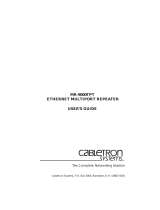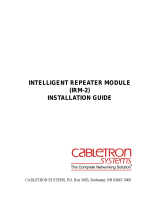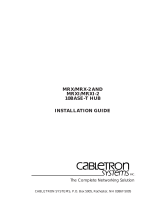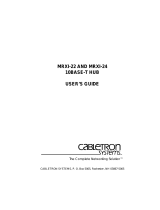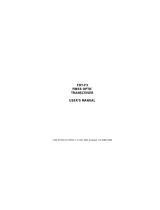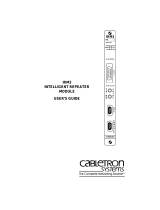Page is loading ...

LR-2000
LOCAL REPEATER
USER'S MANUAL
CABLETRON SYSTEMS, P.O. Box 6257, E. Rochester, New Hampshire 03867
The Complete Networking Solution
Inc.

POWER SUPPLY CORD
The main cord used with this equipment must be a 2 conductor plus ground type
with minimum 0.75 mm square conductors and must incorporate a standard IEC
appliance coupler on one end and a main plug on the other end which is suitable for
the use and application of the product and that is approved for use in the country
of application.
GERMAN:
Die Netzleitung, die mit diesem Geraet benuetzt wird, soll einen zwei Leiter mit
Erdleiter haben, wobei die Leiter mindestens 0.75 mm sind, mit einer normalen IEC
Geraetesteckdose an einem Ende und einem Geraetestecker am anderen Ende
versehen sind, der fuer den Gebrauch und die Anwendung des Geraetes geeignet
und der zum Benuetzen im Lande der Anwendung anerkannt ist.
SPANISH:
El cable principal de la red eléctrica utilizado con este equipo debe tener 2
conductores y 1 toma de tierra con un mínimo de 0.75 mm
2
cada uno y necesita tener
un aparato de acoplamiento standard IEC en un extremo y un enchufe para el cable
principal de la red eléctrica en el otro extremo, lo cual sea adecuado para el uso y
applicación del producto y lo cual sea aprobado para uso en el pais de applicación.
FRENCH:
Le cordon d' alimentation reliant cet appareil au secteur doit obligatoirement avoir
deux fils conducteurs de 0.75 mm
2
minimum et un fil de terre. It doit également être
équipé du côté appareil d'une fiche agrée IEC et du côte secteur, d'une prise adaptée
à l'usage du produit et aux normes du pays où l'appareil est utilisé.

NOTICE
NOTICE
Cabletron Systems reserves the right to make changes in specifications and other
information contained in this document without prior notice. The reader should in all
cases consult Cabletron Systems to determine whether any such changes have been made.
The hardware, firmware, or software described in this manual is subject to change without
notice.
IN NO EVENT SHALL CABLETRON SYSTEMS BE LIABLE FOR ANY INCIDENTAL,
INDIRECT, SPECIAL, OR CONSEQUENTIAL DAMAGES WHATSOEVER
(INCLUDING BUT NOT LIMITED TO LOST PROFITS) ARISING OUT OF OR
RELATED TO THIS MANUAL OR THE INFORMATION CONTAINED IN IT, EVEN IF
CABLETRON SYSTEMS HAS BEEN ADVISED OF, KNOWN, OR SHOULD HAVE
KNOWN, THE POSSIBILITY OF SUCH DAMAGES.
Copyright February 1990 by
Cabletron Systems Inc.
P.O. Box 6257, E. Rochester, NH 03867-6257
All Rights Reserved
Printed in the United States of America
Order number: 9030004-02 Feb. 90
LANVIEW, LR-2000 and LAN-MD are trademarks of Cabletron Systems Inc.
i

FCC NOTICE
FCC NOTICE
This device complies with Part 15 of FCC rules. Operation is subject to the following two
conditions: (1) this device may not cause harmful interference, and (2) this device must
accept any interference received, including interference that may cause undesired
operation.
WARNING: This equipment uses and generates and can radiate radio frequency energy
and if not installed properly and used in accordance with the instruction manual, may
cause interference to radio communications. It has been tested and found to comply with
the limits for a Class A digital device pursuant to Subpart J, of Part 15, of FCC Rules,
which are designed to provide reasonable protection against such interference in a
commercial environment. Operation of this equipment in a residential area is likely to
cause interference in which case the user at his own expense will be required to take
whatever steps may be necessary to correct the interference
If this equipment does cause interference to radio or television, which can be determined
by turning the equipment off and on, the user is encouraged to try to correct the
interference by one or more of the following measures:
• Re-orient the receiving antenna.
• Relocate the LR-2000 with respect to the antenna.
• Move the LR-2000 away from the receiver.
• Plug the LR-2000 into a a different outlet so that the repeater and the receiver are on
different branch circuits.
If necessary, the user should consult the dealer or an experienced radio/television
technician for additional suggestions. The user may find the following booklet prepared by
the Federal Communication Commission helpful:
“How to Identify and Resolve Radio TV Interference Problems”
This booklet is available from the U.S. Government Printing Office, Washington D.C.
20402 - Stock No. 004-000-00345-4
ii

CONTENTS
CONTENTS
CHAPTER PAGE
CHAPTER 1 - INTRODUCTION
1.1 USING THIS MANUAL ........................................................................................1-1
1.2 GETTING HELP....................................................................................................1-1
1.3 THE LR-2000 LOCAL REPEATER ......................................................................1-2
1.4 RELATED USER MANUALS ...............................................................................1-2
CHAPTER 2 - INSTALLATION REQUIREMENTS/SPECIFICATIONS
2.1 NETWORK DESIGN GUIDELINES....................................................................2-1
2.2 LOCATION GUIDELINES ...................................................................................2-1
2.3 SPECIFICATIONS ................................................................................................2-2
CHAPTER 3 - CONNECTING THE LR-2000
3.1 UNPACKING THE LR-2000 .................................................................................3-1
3.2 CONNECTING THE LR-2000 TO YOUR NETWORK........................................3-1
CHAPTER 4 - TESTING AND TROUBLESHOOTING
4.1 INSTALLATION CHECK-OUT ............................................................................4-1
4.2 USING LANVIEW .................................................................................................4-2
iii

Page 1 - 1
INTRODUCTION
CHAPTER 1
INTRODUCTION
Welcome to the Cabletron Systems LR-2000 Local Repeater User Manual. We have
designed this manual to serve as a simple installation and reference guide for the
LR-2000. The LR-2000 allows users to expand their networks, utilizing any Ethernet
transmission media, while maintaining the integrity of data packets passing through the
network. This unit fully conforms to IEEE 802.3 specifications and provides the flexibility
to interconnect networks using Ethernet Version 1, Version 2, and/or IEEE 802.3
equipment.
You should read this manual thoroughly to gain a full understanding of the LR-2000 and
its capabilities
1.1 USING THIS MANUAL
Chapter 1, Introduction, discusses the capabilities of Cabletron Systems' LR-2000 Local
Repeater. The chapter concludes with a list of related user manuals.
Chapter 2, Installation Requirements/Specifications, contains a list of hardware,
software, location, and environmental requirements that must be met before installing the
LR-2000. It also contains the operating specifications for the LR-2000.
Chapter 3, Installing the LR-2000, contains steps for unpacking the LR-2000, connecting
network segments to the LR-2000 via the appropriate transceivers, and powering the
unit up.
Chapter 4, Testing and Troubleshooting, contains procedures for checking the
proper installation of the LR-2000, and a description of the LANVIEW LEDs and
their function.
You should have a general working knowledge of Ethernet or IEEE 802.3 type data
communications networks and their physical layer components before installing the
LR-2000 on your network.
1.2 GETTING HELP
If you need additional support related to Cabletron Systems' LR-2000, or if you have any
comments, suggestions, or questions relating to this manual, feel free to contact Cabletron
Systems' Technical Support at:
Cabletron Systems
P.O. Box 6257
E. Rochester, NH 03867-6257
Phone: (603) 332-9400

INTRODUCTION
Page 1 - 2
1.3 THE LR-2000 LOCAL REPEATER
The LR-2000 easily connects two network segments, in any combination, made of a variety
of Ethernet transmission media, including 10BASE-T Twisted Pair, Fiber Optic, and thick
or thin Coaxial Cabling. The segments are connected by first attaching an external
transceiver to each segment that will be connected to the LR-2000. An attachment unit
interface (AUI) cable is then used to connect the transceiver on each segment to the AUI
ports located on the rear of the repeater. The two segments are linked when they are
attached to the repeater.
The LR-2000, being an IEEE 802.3 compliant repeater, will transmit re-timed data
packets, regenerate preambles, extend collision fragments, automatically partition
problem segments, and automatically reconnect non-problem segments. If a problem
develops on a segment connected to the LR-2000, just those devices on that segment will
be affected. Once the problem is corrected, those devices will automatically be reconnected
to the network.
The LR-2000 incorporates Cabletron Systems' LANVIEW diagnostic and monitoring
system. LANVIEW is a series of LEDs incorporated into all Cabletron Systems' products.
Should a problem arise, troubleshooting of power failures, collisions, cable faults or many
other problems can be diagnosed rapidly by using a series of LEDs.
1.4 RELATED USER MANUALS
The manuals listed below should be used to supplement the procedures and other
technical data provided in this manual. The procedures contained in these manuals will
be referenced, rather than repeated in this manual.
• Cabletron Systems' TPT-T 10BASE-T Twisted Pair Transceiver User's Manual
• Cabletron Systems' FOT-F Fiber Optic Transceiver User’s Manual
• Cabletron Systems' ST-500 Coaxial Transceiver User’s Manual
• Cabletron Systems' TMS-3 Thin-net Transceiver User’s Manual
• Cabletron Systems' LAN-MD Portable Ethernet Tester User’s Manual

Page 2 - 1
INSTALLATION REQUIREMENTS/SPECIFICATIONS
CHAPTER 2
INSTALLATION REQUIREMENTS/SPECIFICATIONS
This chapter lists the location and network requirements needed for connecting the
LR-2000 to your network. No special skills or tools are required to install the unit on an
Ethernet network. This chapter also lists the specifications and power requirements for
the LR-2000.
Review all specifications and requirements in this chapter before you install the LR-2000.
If you do not, unsatisfactory network performance may result.
2.1 NETWORK DESIGN GUIDELINES
You must follow the network design guidelines listed in this section. If you do not,
unsatisfactory performance may result.
• The transceivers to which the LR-2000 will be connected must meet IEEE 802.3
standards and must have the SQE test function disabled.
• The AUI cables connecting the LR-2000 to the transceivers on the network must be
IEEE 802.3 type cables and must not exceed 50 meters (164 feet) in length.
• From its source address to its destination address, a data packet may pass through
four repeaters.
2.2 LOCATION GUIDELINES
The following guidelines must be followed to select a site for the LR-2000 Local Repeater.
If not, unsatisfactory network performance may result.
• An unrestricted free surface area of 53.34 cm (21 in) wide, 45.72 (18 in) deep and
15.24 cm (6 in) high is needed.
• A USA standard 3 prong power receptacle must be located within 2.13 m (7 ft) of
the site.
• If a shelving unit is to be used, it must be able to support 13.61 kg (30 lbs) of
static weight.
• The temperature of the location must be maintained between 5° and 40° C (41° and
104° F). Temperature changes of greater than 10° C (50° F) per hour must not occur.

Page 2 - 2
INSTALLATION REQUIREMENTS/SPECIFICATIONS
2.3 SPECIFICATIONS
This section contains the specifications for the Cabletron Systems LR-2000 Local
Repeater. Cabletron Systems reserves the right to change these specifications at any time
without notice.
GENERAL
Delay Times: (any segment in to all segments out)
Parameter: Typical Worst
Value Case
Start of Packet: 500 ns 600 ns
Collision to JAM:
Receive Mode 200 ns 300 ns
Transmit Mode 500 ns 625 ns
Preamble:
Input: Minimum of 20 bits required.
Output: 64 bits min. (last 2 bits are 1, 1).
JAM output: A pattern of 1, 0 is sent to one or both of the
segments if a collision occurs.
Fragment Extension: Any packet less than 96 bits long. (Packet
fragments are extended using the JAM [1, 0]
data pattern).
FAULT Protection: Each segment will disconnect itself from the other
segment if 32 consecutive collisions occur, or if the
collision detector of a segment is on for longer than
approximately 2.4 ms. This FAULT protection will
reset automatically after one packet is transmitted
onto the FAULT protected segment without
causing a collision.
LANVIEW LEDs
PWR Indicates that the LR-2000 is receiving power.
XCVR PWR Indicates that the LR-2000 is providing power to
the transceivers connected to it.
JAM Indicates that the LR-2000 is propagating a
collision on one segment to the other segment
connected to the repeater.

Page 2 - 3
INSTALLATION REQUIREMENTS/SPECIFICATIONS
LANVIEW LEDs (Cont.)
NOTE: There is one RECEIVE, COLLISION, and FAULT LED for each segment.
RECEIVE Indicates that the LR-2000 is receiving a data
packet on that segment.
COLLISION Indicates that a collision is occurring on
that segment.
FAULT Indicates that the LR-2000 has electrically
disconnected that segment from the network due
to a cable fault or 32 consecutive collisions.
AUI INTERFACE (PORT 1 AND 2)
Type: 15 position D type receptacle (Fig. 2-1).
Pin 1 Logic Ref. Pin 9 Collision -
2 Collision + 10 Transmit -
3 Transmit + 11 Logic Ref.
4 Logic Ref. 12 Receive -
5 Receive + 13 Power (+12 Vdc)
6 Power return 14 Logic Ref.
7 No Connection 15 No Connection
8 Logic Ref.
Connector Shell: Protective Ground
Figure 2-1. Pinout Connections
POWER SUPPLY REQUIREMENTS
Note: The LR-2000 automatically differentiates and selects for the proper input voltage.
Parameter Typical Worst
Value Case
Input Voltage Vac 47-63 Hz
120 Volts Input: 0.3 A @ 120 V 0.5 A @ 90 to 130 V
220 Volts Input: 0.15 A @ 220 V 0.25 A @ 180 to 250 V
Input Current: 0.25 amp 1.0 amp
Output Voltage: 12 Vdc 11.5 to 15.5 Vdc

Page 2 - 4
INSTALLATION REQUIREMENTS/SPECIFICATIONS
POWER SUPPLY REQUIREMENTS (Cont.)
Overload Protection
Input: (1) 3AG 3 amp fuse.
Output: (1) 3AG 1 amp fuse per AUI port.
ENVIRONMENTAL REQUIREMENTS
Operating Temperature: +5° to +40° C (41° to 104° F)
Non-operating Temperature: -30° to +90° C (-86° to 194° F)
Operating Humidity: 5 to 95% (non-condensing)
SAFETY
WARNING: It is the responsibility of the person who sells the system of which the
LR-2000 will be a part of to ensure that the total system meets allowed limits of
conducted and radiated emissions.
Designed in accordance with UL478, UL910, NEC 725-2(b), CSA, IEC, TUV,
VDE 0871B. Meets FCC part 15, Subparagraph J, Class B limits.
SERVICE
MTBF (MHBK-217D): > 100,522 hrs. projected.
MTTR: <0.5 hrs.
PHYSICAL
Dimensions: 8.13 x 38.1 x 31.5 cm
(3.2H x 15.0W x 12.4D inches)
Weight
Unit: 3.17 kg (7 lbs)
Shipping: 3.63 kg (8 lbs)

CONNECTING THE LR-2000
Page 3 - 1
CHAPTER 3
CONNECTING THE LR-2000
This chapter contains instructions for connecting Cabletron Systems' LR-2000 Local
Repeater onto your network. Check that all requirements listed in Chapter 2,
Installation Requirements/Specifications, are met before installing the LR-2000.
3.1 UNPACKING THE LR-2000
Unpack the LR-2000 as follows:
1. Carefully remove the repeater from shipping box.
2. Slide the two foam end caps off the repeater.
3. Remove the repeater from protective plastic bag and set the repeater aside in a
safe place. Save the shipping box and materials in the event that the unit has to
be reshipped.
4. Remove the plastic bag containing the accessory package and check that it contains
the following items:
• One 8 foot USA power cord.
• One cable support bracket.
• Two 8-32 x .375 in. screws.
• Three 6 in. cable ties.
3.2 CONNECTING THE LR-2000 TO YOUR NETWORK
The LR-2000 is designed to be easily connected to your network without the use of any
special tools or equipment.
Connect the LR-2000 to the network as follows:
1. Using the two 8-32 screws (3, Fig. 3-1), attach the cable support (2) to the
repeater (1).
2. Place the repeater on the selected site. Be sure that the site meets the guidelines
listed in Section 2.2.
CAUTION: Ensure that the external transceivers to which the LR-2000 will be connected
has the signal quality error (SQE or “heartbeat”) test function disabled. The LR-2000 will
not operate if the transceivers have the SQE test function enabled, and the network will be
unusable. Refer to the applicable transceiver manual.
3. Attach an external transceiver (1, 9 Fig. 3-2) to each network segment that the
LR-2000 (4) will be connected to. Refer to the applicable transceiver manual.

CONNECTING THE LR-2000
Page 3 - 2
Figure 3-1. Cable Support Installation
4. Attach an AUI cable (2, 8), no longer than 50 meters in length, to both transceivers
connected in step 3.
5. Connect the AUI cable (2) from transceiver 1 (1) to AUI port 1 (3), located on the
back side of the LR-2000.
6. Connect the AUI cable (8) from transceiver 2 (9) to AUI port 2 (5).
7. Plug the power cord (7) into the power receptacle (6) located on the back side of
the repeater.
8. Plug the power cord into a wall receptacle.
9. Turn the power switch, located next to the power receptacle, to the ON position.
The PWR LED, indicating that the repeater is receiving power, and the XCVR PWR
LED, indicating that the repeater is providing power to the transceivers connected to
it, should be lit.
10. Using the cable ties provided, strain relief both AUI cables and the power cord to the
cable supports located on the back side of the repeater.
The LR-2000 is now ready for operation. It is recommended that the connections be tested
prior to transmitting data. Refer to Chapter 4, Testing and Troubleshooting.

Page 4 - 1
TESTING AND TROUBLESHOOTING
CHAPTER 4
TESTING AND TROUBLESHOOTING
This chapter lists procedures to test the LR-2000 Local Repeater after it has been
connected to the network. A description of LANVIEW and its function in troubleshooting
physical layer network problems is also given.
4.1 INSTALLATION CHECK-OUT
This section contains procedures to test the LR-2000 Local Repeater after it has been
installed to ensure that the the physical layer of the network is operating properly. Two
Ethernet node testers that will generate valid data packets, such as Cabletron Systems'
LAN-MDs, are required for this procedure.
Before you begin, test each segment connected to the repeater to ensure that the segment
meets IEEE 802.3 specification limits.
1. Using a transceiver (1, Fig. 4-1) and an AUI cable, connect a LAN-MD (2) to either of
the segments connected to the LR-2000 (3).
2. Select and run test 6 - SERVER.
3. Verify that the Test Status PASS LED is lit and that the status code reads 000 or
001. If these two conditions are met, this LAN-MD now acts as a SERVER unit and
will act as a packet echoer when used with another LAN-MD.
4. Using a transceiver (5) and an AUI cable, connect another LAN-MD (4) to the other
segment connected to the LR-2000.
5. Select and run test 4 - NODE on the LAN-MD connected in step 4.
6. Verify that this test passes. At least 100 packets should be sent and received with no
errors. The packets will be received from and sent back to the LAN-MD acting as
the SERVER.
When the LR-2000 Local Repeater has successfully completed these tests, it is ready
for normal operation. If any failures were noted, please contact Cabletron Systems'
Technical Support.

Page 4 - 2
TESTING AND TROUBLESHOOTING
Figure 4-1. Checkout Configuration
4.2 USING LANVIEW
The LR-2000 Local Repeater system uses Cabletron Systems' built-in visual diagnostic
and status monitoring system, LANVIEW. Using LANVIEW, a network troubleshooter
can quickly scan the LANVIEW LEDs to observe network status or to diagnose network
problems to determine which node or segment is faulty.
The following section discusses the function and the purpose of each LANVIEW LED on
the LR-2000. Refer to Figure 4-2.
Power (PWR) LED
When lit, this green LED indicates that the LR-2000 is receiving power. If this LED is not
lit, the problem may be with the input power or the LR-2000.
Transceiver Power (XCVR PWR) LED
When lit, this green LED indicates that the LR-2000 is providing power to the external
transceivers connected to the LR-2000. If this LED is not lit, power is not being provided
to one or both of the transceivers, and the problem may be in the LR-2000.

Page 4 - 3
TESTING AND TROUBLESHOOTING
Figure 4-2. LANVIEW LEDs
Jam (JAM) LED
This red LED normally flashes on and off to indicate that the LR-2000 is propagating a
collision from the segment on which the collision is occurring to the other segment
connected to the repeater. When this LED flashes, a pattern of 1,0 is sent to each segment
to indicate that a collision is occurring on one of the segments. What will be observed is
that the COLLISION LED for one segment will flash, indicating a collision, causing the
JAM LED to flash.
NOTE: There is one Receive, Collision, and Fault LED for each port on the LR-2000.
Receive (RECEIVE) LED
This yellow LED normally flashes on and off to indicate that the LR-2000 is repeating the
data packet being received from that segment. The rate at which the LED flashes will
increase as network activity increases.
Collision (COLLISION) LED
This red LED normally flashes on and off to indicate that a collision is occurring on the
indicated segment. The rate at which the LED flashes will increase as network activity
increases, since more collisions are likely occur.
Fault (FAULT) LED
A lit red FAULT LED indicates that the LR-2000 has disconnected that segment from the
network because 32 consecutive collisions have occurred on the segment, or because the
collision detector was on for longer than 2.4 ms. The FAULT LED will go out after one
packet is transmitted onto the segment with the fault without causing a collision.
/



